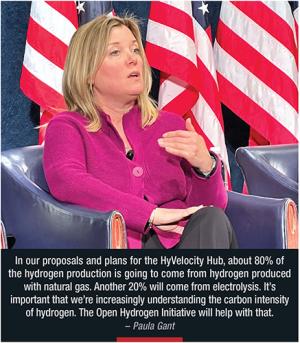USEA
Moderator Mark Menezes is CEO of the United States Energy Association. Paula Gant is the CEO of GTI Energy.
The United States Energy Association held its 20th State of the Energy Industry Forum at the National Press Club in Washington, D.C. in late January 2024. This Innovation panel focused on breakthrough technologies to achieve net-zero goals and increase access to affordable and reliable energy. Technologies are being developed to adapt natural gas turbines to increased use of hydrogen blends. DOE has launched a series of initiatives to foster the development of hydrogen, long-duration energy storage, and other new technologies.

The panel was moderated by USEA CEO Mark Menezes and included Fuel Cell & Hydrogen Energy Association CEO Frank Wolak, Gas Turbines Association Vice Chair Carlos Koeneke, GTI Energy CEO Paula Gant, and National Hydropower Association CEO Malcolm Woolf. Enjoy these excerpted remarks by GTI Energy CEO Paula Gant.
GTI Energy CEO Paula Gant: At GTI Energy we're optimistic about the types of transitions that are underway and the future of energy systems. A recent point of optimism, for me, comes out of COP28, which is not something I usually say when reporting on the COPs.
It extends on optimism that I'm seeing on government policy, where we're seeing a broadening of the perspective on energy transition and what's needed for energy systems, as we think about decarbonization, and a broadened perspective about economy-wide, deep decarbonization. Also, what's needed to maintain the competitiveness of our economies in ways that provide for rising standards of living, not just here in the U.S., but around the world.

In recent U.S. government policy, whether it's the Inflation Reduction Act or the Infrastructure and Jobs Act, we've seen an expansion beyond just focusing on energy systems. Think about industrial decarbonization, for example, and decarbonizing transport, and putting research dollars into what are the types of disruptive innovations that are going to be needed.
We saw a continuation of that at COP and the global climate conferences, moving beyond just a focus on electronics and thinking about industrial decarbonization, or requirement for fuels, carbon management. So, putting carbon dioxide to use, not just sequestering it.
As well as a more robust conversation about affordability and access than we've ever had at COP, and that energy efficiency has made it onto the climate stage, which weirdly it wasn't. That being a takeaway from COP28 was news to me. How could we not have been talking about energy efficiency? To me, that suggests we're getting real now.
We're opening up our aperture. This is our economy. This is about jobs and at GTI Energy, when we think about our role in helping out, that's what we see as our role.
We sit at the intersection of tradition and innovation for the last eighty years, working with you and others in these spaces to effect improvements in energy systems and equipment and how they operate. We're always transitioning. Our role is to build collaborations and to make sure that we're taking a systems thinking perspective.
I hope today to talk to you about the three things I'm optimistic about. One is hydrogen production and the investments that are being made in scaling hydrogen ecosystems in regions across the country through the Clean Hydrogen Hubs.
The Department of Energy announced seven billion in awards for seven hubs. We're involved in three of them, and we lead in the Gulf Coast region. Second, the progress that's being made, getting the standards in place so we are more accurately accounting for the carbon intensity of fuels so we can make better decisions.
We have a couple of things going on in that regard in our Open Hydrogen Initiative, which are creating open-source protocols for putting measurement tools to work and calculating carbon intensity. Then third, I hope to talk to you about the importance of infrastructure and particularly infrastructure that moves molecules.
If we look out to mid-century, all the analysis of net zero that are widely cited and credible and including all of those that assume aggressive electrification, rather than systems, still indicate that between fifty and sixty percent of final energy demand will be met with molecules.
We're going to need molecules. So, the big questions are, "How are we going to move them? How are we going to store them? How are we going to deliver them? How are we going to lower the carbon intensity of them? How are we going to use them in ways that don't create emissions?" Lots of options, lots of work going on in that space.
United States Energy Association CEO and moderator Mark Menezes: There are talks about methane measurement, methane sensor technologies now that we've developed to be able to measure, detect, and capture the methane. Can you talk a little bit about that? Since clean hydrogen is based on carbon intensity, can you elaborate?
Paula Gant: We're about two years into a collaborative initiative with about forty companies, investors, and equipment manufacturers, creating a different protocol for operationalizing all of the measurement technologies that have come into the space around the ambition for preventing methane leakages from natural gas systems over the last decade.
We've seen a lot of tension in that space. I've worked on this issue for about a dozen years in various roles, and we've got a lot of ambition and commitments, and that has brought a lot of interest into the space, a lot of technologies, and a lot of noise about how do you know if the data's good, how do you use technologies, and how do you trust what people are saying?
What the Open Hydrogen Initiative has done is bring all these people together to figure out, depending on which part of the U.S. onshore natural gas value chain — we're working in six segments from wellhead to point of liquefaction — how do you think about all these array of measurement technologies and fit them to use? Depending on what facility you have, this might be flyover techniques, it might be point sensors, it might be satellite imagery, you name it. How do we take all of that and figure out what is fit for purpose in a particular instance?
Then when you get the data off of those, how do you put it to use in your existing systems, because that's the whole point of data? Have confidence to make better decisions and their operational decisions, investment decisions, regulatory decisions.
Then the next set of protocols is how do you take that data, which you have confidence in, and how do you use it to compare to your existing greenhouse gas reporting, which is all based on emissions factors? So, progressive modernization of how we get to measure informed carbon intensities for methane.
These are important for a variety of decisions we need to make. We want the cleanest gas. We want to be exporting the cleanest gas. We want to be producing the cleanest gas of all.
This is one of the ways we verify that. It's also important if we think about pathways for clean hydrogen to scale up. Natural gas to hydrogen is going to be a vital part of scaling up our hydrogen economy over the next twenty years or longer, probably.
We are leading a HyVelocity Hub. It is a number of partners who represent ownership of about a thousand miles of dedicated hydrogen pipelines, about two and a half tons of carbon dioxide storage, fifty gigawatts of renewables, and abundant natural gas supply.
In our proposals and plans for the HyVelocity Hub, about eighty percent of the hydrogen production is going to come from hydrogen produced with natural gas. Another twenty percent will come from electrolysis. So, it's important that we're increasingly understanding the carbon intensity of hydrogen. The Open Hydrogen Initiative will help with that.
In addition, the Open Hydrogen Initiative is doing the same thing for hydrogen. It's helping to create open-source protocols for calculating the carbon intensity of hydrogen at the point of production. So, we can all say goodbye to the color wheel and get real about the clarity of information we need to make really good decisions on hydrogen
State of the Energy Industry Forum articles at fortnightly.com:
The panel was moderated by United States Energy Association CEO Mark Menezes. Excerpts feature Edison Electric Institute CEO Dan Brouillette, EPRI CEO Arshad Mansoor, and Nuclear Energy Institute CEO Maria Korsnick.
On the panel were United States Energy Association CEO and moderator Mark Menezes, American Gas Association CEO Karen Harbert, America’s Power CEO Michelle Bloodworth, American Public Power Association CEO Scott Corwin, Large Public Power Council President John Di Stasio, and National Rural Electric Cooperative Association CEO Jim Matheson.
With excerpts from United States Energy Association CEO and moderator Mark Menezes and GTI Energy CEO Paula Gant.



